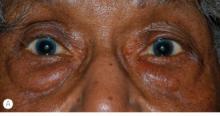How many times a week do you get asked by your patients how to get rid of the "dark circles" under their eyes? The term is a catch-all used by physicians and patients to refer to problems that have a vast range of genetic, environmental, and skin-related causes. It is a common and frustrating problem, with little structure in its definition and few full-proof treatments.
Below is my proposed classification system for the definition of dark circles and clinical pearls for their treatment. Most patients, however, have a combination of each type and multifactorial causes that need to be addressed.
Infraorbital fat pad protrusion. Also known as "eye bags."
Blepharoplasty is the best, and for now the only, solution for severe fat pad prominence. Referral to a board certified plastic surgeon or dermatologic surgeon is recommended.
If the protrusion is mild and tear troughs are prominent, fillers may be injected into the tear trough area to help mask the protrusion. My favorites for this area are hyalauronic acid fillers like Juvéderm Ultra or Restlyane, sometimes double diluted with normal saline or injected with a 32-gauge needle.
For loose skin with "bags," radiofrequency lasers can provide some benefit. The Thermage eyelid tip produces results over 3-6 months, with repeat treatment possible at 6 months. I always advise patients that this treatment is not a replacement for surgery but can provide some benefit in those who are not surgical candidates or who do not want surgery.
Infraorbital edema. Also known as "puffiness."
The infraorbital skin is very thin and highly sensitive to fluid compartmentalization. Seasonal allergies, sinus infections, crying or water retention from high blood pressure or eating high sodium foods are some of the reasons the loose, thin epidermis becomes edematous.
Treat seasonal allergies with over-the-counter allergy medications or prescription medications for resistant allergies or possible sinus infections.
Advise patients to switch their sleep position. Sleep position can be contributing to undereye bags through gravity. Sleeping on the side or stomach can encourage fluids to collect under the eyes. If patients report being a side sleeper, you may notice a heavier bag on the side they report sleeping on. Patients who wake up with puffy eyes can sleep on their back and add an extra pillow under their head.
Also advise patients to avoid rubbing their eyes, going to bed with makeup on, and using harsh cleansers. Anything that irritates the eyes can cause fluids to pool. Sleeping in eye makeup can irritate eyes, causing undereye edema.
Eye bags could be a sign of an underlying medical condition, especially if bags appear suddenly and none of the above conditions apply. Thyroid, cardiovascular, or kidney problems can cause undereye fluid retention and patients will need to see their primary care doctors for further evaluation.
Patients can place an ice pack, slices of cucumbers, chilled tea bags, refrigerated eye gels, or even a package of frozen peas on their eyes. This can constrict leaky blood vessels and lessen the periorbital edema.
Periorbital hyperpigmentation. Also known as "dark circles."
Pigmentation of the periorbital skin is very common in skin of color because of the increased melanin content. Genetics, rubbing, and inflammatory skin diseases such as eczema may play a role in exacerbating the pigmentation of the thin undereye skin.
Again, advise patients to avoid rubbing the area. Chronic rubbing and the development of lichen simplex chronicus can lead to dark, thickened undereye skin.
Retinoic acid creams can help slough the dark pigmented skin. It should, however, be used in very small amounts that increase over a few weeks to avoid severe irritation.
Skin lightening creams with azaleic acid, kojic acid, and glycolic acid can be found in varying strengths. Hydroquinone creams have been successful in lightening undereye hyperpigmentation. Strengths in over-the-counter preparations start at 1-2% and in prescription strength can be compounded to higher than 4%, but caution should be used to avoid further irritation and potential post-inflammatory pigment from these products.
Light chemical peels can assist in lightening dark undereye pigmentation. Peels with hydroquinone or retinoic acid can be used for an added lightening benefit.
Intense pulse light can help minimize undereye pigmentation, particularly UV-induced pigmentation. Q-switched lasers have also been reported to be effective.
Infraorbital tear trough depression.
Most often, dark circles aren't about changes in the color of the skin. Instead, they're created by a loss of volume in the area around the eye, exposing the orbital bone and creating a hollow trough that shows up as a dark circle. These changes are often genetic, but significant weigh loss can also expose undereye tear trough depressions.


